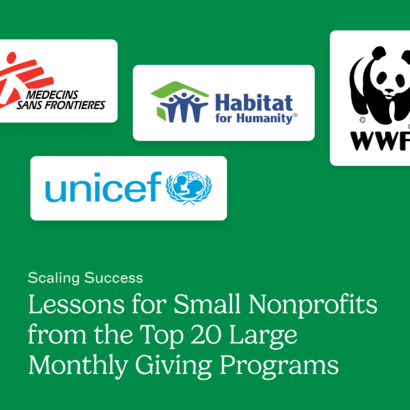COVID-19 may have put a damper on your operations, but that doesn’t mean your organization can’t still make a difference. If you’re like many nonprofits grappling with the right way to communicate with your audience, here are some great ways you can still communicate at this time.
How to use email during a crisis
There is a lot of noise out there and although social media is also a great tool to connect at this time (we have a few bonus suggestions using those channels, below) your email list is the best place to start as those are the people who have connected with you in the past, who have participated in (or donated to) your cause before, and it is a platform that is not beholden to an algorithm.
There are a host of reasons why you would want to use email as your method of communication at this time—it’s cost-effective, you can track link clicks, it’s an easy way to communicate changes and your immediate needs, and you can easily add links to your donor pages or other areas of your site for information.
You may also have specific needs of communication around how the crisis affects your fundraising efforts, events or new avenues you’re taking to support those in need. In that case, here are a few great examples in each of those areas:
Idea 1: Communicating a change to your live event
Gateway Public Schools had a live 70’s themed event originally planned for March 14 that was primed to raise $70,000 in funds. Instead of taking this hit, the organization hosted a live, streamed telethon via YouTube, communicating with the following email:
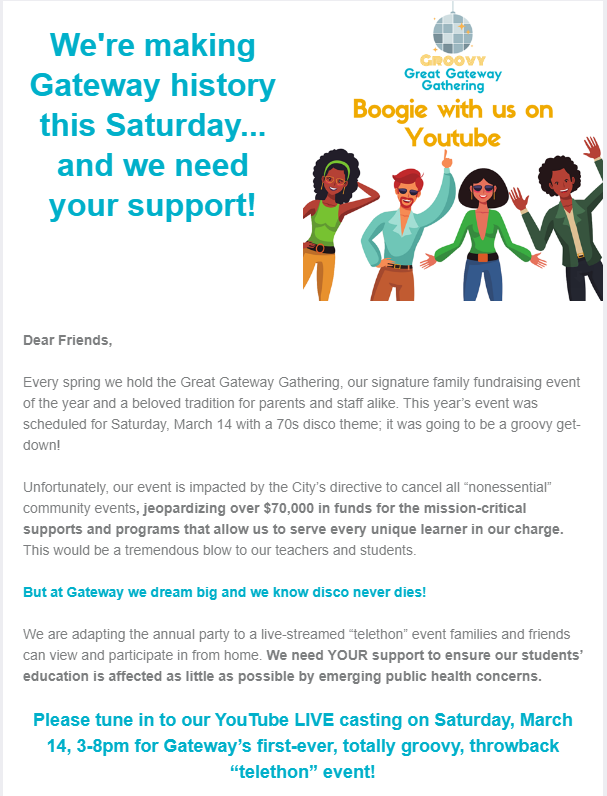
Why this email is great:
- It explains the event that has been impacted
- It provides a dollar amount of just what that impact is
- It provides an alternative solution—a live-streamed telethon in the live event’s place
After the event, Gateway Public Schools added the live stream link to its website for those that wished to view it as a recording—the organization even surpassed its $70k goal!
Idea 2: Sharing stories of impact
The Bronx Zoo picked up on the story they had already been sharing earlier in the year—that of Khyber the snow leopard—in its email fundraising ask.

Why this email is great:
- It showcases that while the crisis affects people, it also has a big impact on animals and wildlife
- It puts a face and name to a creature in need—and one that readers would likely know from previous stories and highlights
- It is an ask that comes from a specific person within the organization
- It makes the point that while zoos may be closed, donors can still show up for these creatures even if they can’t see them physically at this time
Idea 3: Resources for those in need
Council of Churches of the Ozarks sent a great email at the beginning of the month full of resources and supportive information for its members. While it leads with the latest COVID-19 service updates it continues with so many additional resources helpful for many members of its community.

Why this email is great:
- It provides a quick update/link for the organization’s change in services/procedures at the top of the email
- It provides community guidelines for staying safe and encourages sharing with others
- It recognizes that people may be having a hard time and provides links for coping
- It provides resources for food banks and also just-for-fun activities for children
Council of Churches of the Ozarks took a very proactive approach to this email—they tried to address questions and provide as many resources and links to information as it could, anticipating the types of questions its audience might have or the pieces of information that seem to be most pressing at this time.
Idea 4: Your response to the crisis
JMG sent an email to its constituents that not only indicated why its programs and funding is so critical, but also outlining what the organization has quickly put in place as its response to COVID-19.
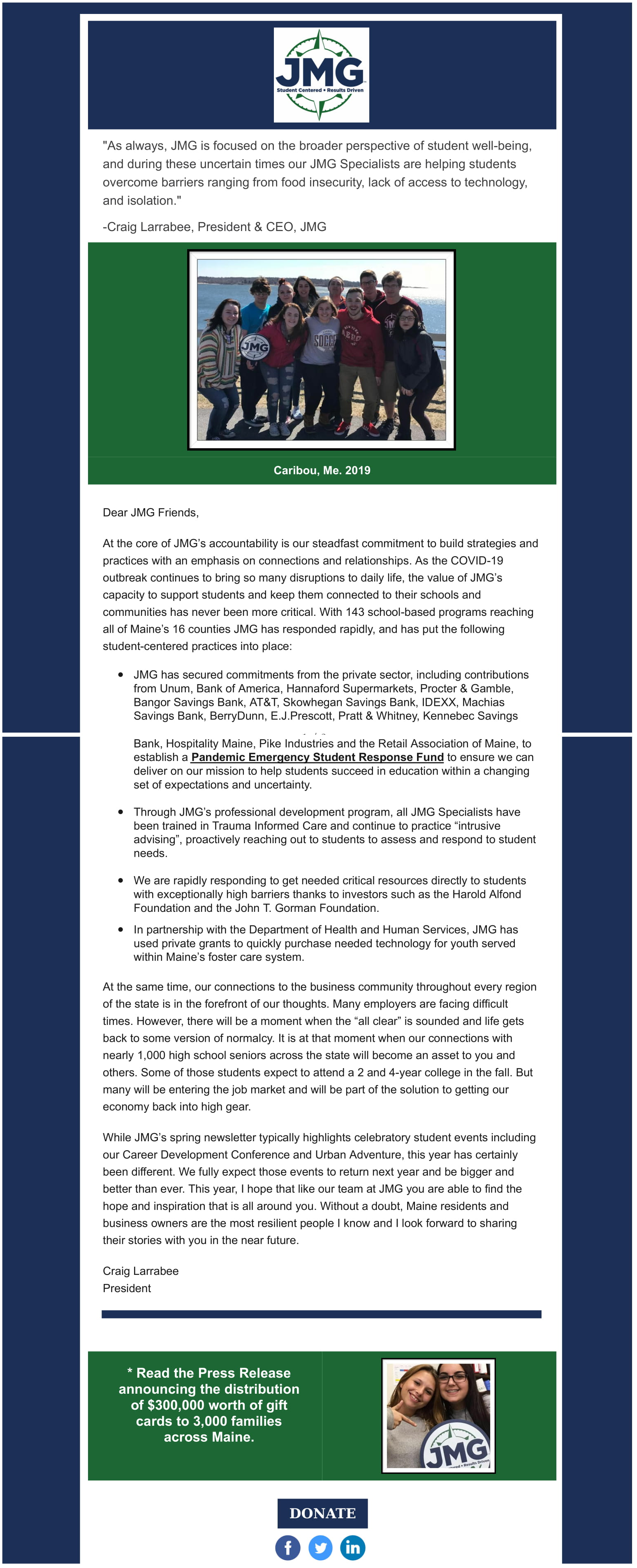
Why this email is great:
- It begins with a direct message from the CEO
- It calls out large donors and sponsors as part of a NEW Pandemic Emergency Student Response Fund, started in response to COVID-19
- It answers questions to continued training and outreach to students during this time
- It highlights recent partnerships as a response to the crisis
While the email is not a direct ask, the organization is also mindful to close with a button linking out to its online donation page for those with the capacity to give.
Idea 5: The importance of giving now
Just as a crisis can have a variety of impacts on individuals, so can it on organizations—some are in dire need of donations because their services are needed the most during times of crisis. Inter-Faith Food Shuttle is one such organization. The organization recently sent out an email with various ways to give safely, even with stay-at-home orders and other virtual ways you can help support the organization.
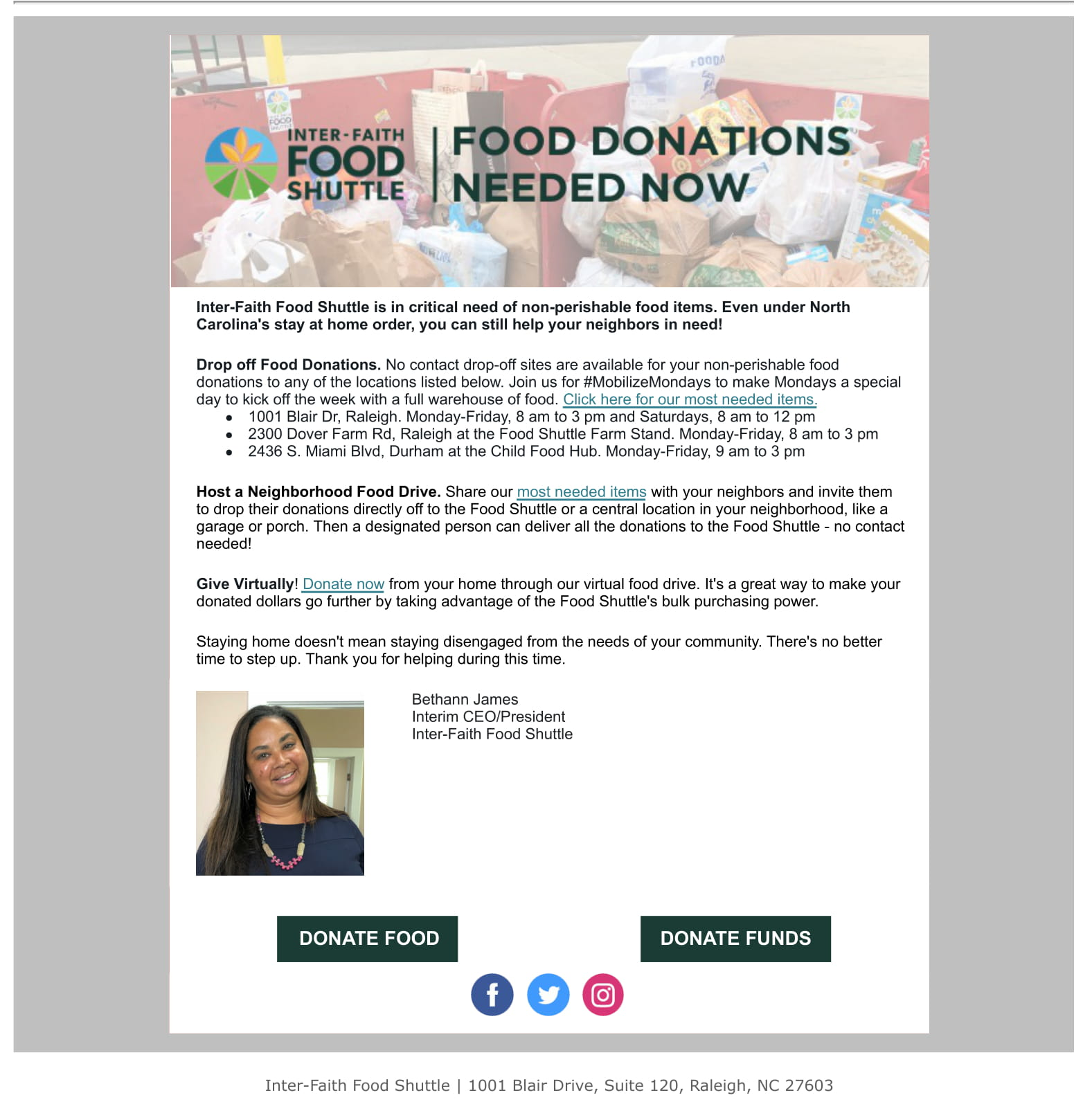
Why this email is great:
- It outlines the critical need right away in the first sentence
- It provides three different ways to make a different—drop off locations, hosting a neighborhood food drive, or giving virtually (online)
- It outlines specific, most-needed items needed at this time
- It’s short, to-the-point and full of helpful links for more information
This is another example of an email that is signed by an individual at the organization as well. And as an added personal touch, the CEO has included her picture in the signature of the email; it’s always nice to have a face to go with a name.
What is the right email message?
While everyone’s needs are different, the best thing you can do is be real, be transparent and be honest. It is OK to acknowledge that the current situation has impacted your organization’s funds. It’s OK to acknowledge that you don’t have all the answers right now but that you’re working hard to figure out your next steps.
Likewise, be sure that you have something legitimate to say. If there isn’t a change, an update or a specific need that you’re asking for in your email, you may want to think about waiting to send one out.
Additional tools you can use to connect
While the tools below can also be used for fundraising asks, the ideas below are centered around connecting and how you can still create relationships with your donors even if an ask is not involved. Many times, your donors want to feel acknowledged. It’s still (always) the right time to reach out and see how your donors are doing.
Social media
Brighten your audience’s day by providing them with fun activities or notes of encouragement throughout the day. Think of the Getty Museum’s Artwork Challenge that has been floating around the past few weeks. The organization is taking to its social media channels to challenge users to recreate their favorite artwork with things within their homes. It provides a fun activity that people can do while still practicing social distancing—with or without others in the home with them.
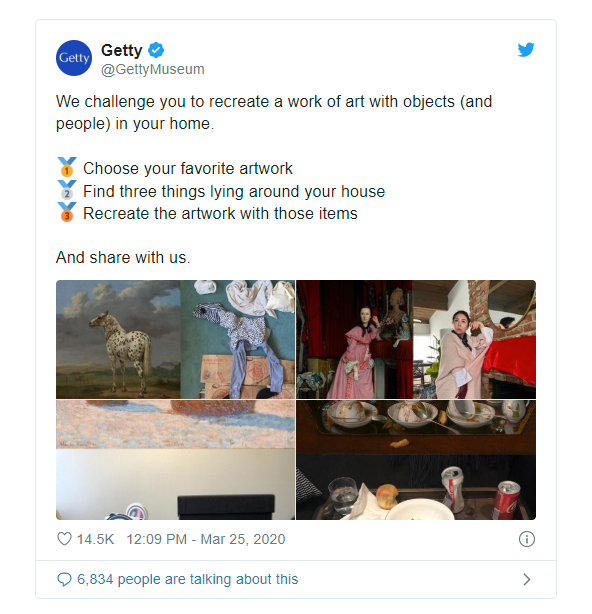
Phone or video conferencing apps
Take this time to call your major donors or sponsors just to ask how they are doing. You can take this time to thank them for their past support or to see if they have any questions for you. Let them know that you are also here for them if anything comes up or to answer any questions they may have. This shouldn’t be a solicitation call—just a feel-good call to acknowledge those that have made a significant impact on your organization in the past.
You’re not alone. Many organizations are trying to figure out the best time to connect, what to say when they do connect and how often it is appropriate to reach out to their constituents. On the whole, your donors want to give if they have the means to do so right now—it makes them feel a bit in control and provides them with the feeling that they are helping in any way that they can. Those that cannot give at this time will appreciate that you are still providing updates and doing your part to keep your organization running; those that are in the position to be able to donate will appreciate that you’re making it easy for them to do so.



